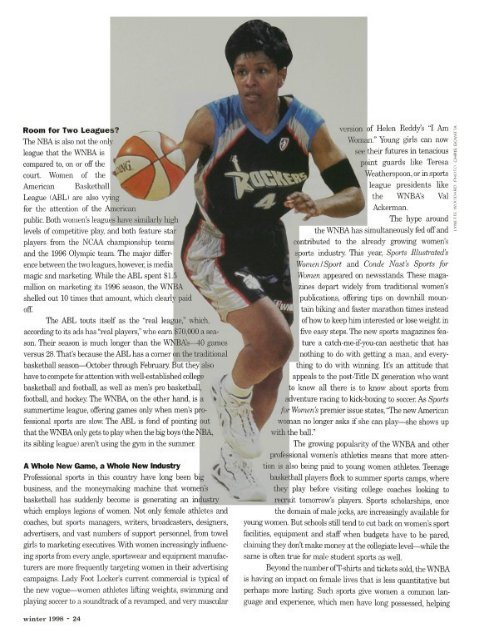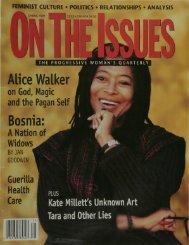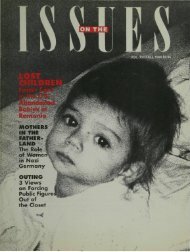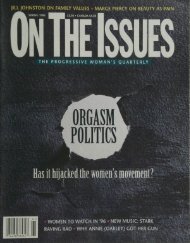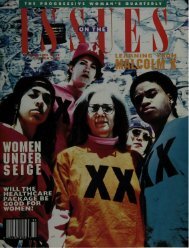women histories, incest sexual abuse. institutionalized. But what if ...
women histories, incest sexual abuse. institutionalized. But what if ...
women histories, incest sexual abuse. institutionalized. But what if ...
Create successful ePaper yourself
Turn your PDF publications into a flip-book with our unique Google optimized e-Paper software.
Room for Two Leagues?<br />
The NBA is also not the only<br />
league that the WNBA is<br />
compared to, on or off the I<br />
court. Women of the I<br />
American Basketball<br />
League (ABL) are also vying<br />
for the attention of the American<br />
public. Both <strong>women</strong>'s leagues have similarly high<br />
levels of competitive play, and both feature stal<br />
players from the NCAA championship teama<br />
and the 1996 Olympic team. The major d<strong>if</strong>fer-1<br />
ence between the two leagues, however, is medial<br />
magic and marketing. While the ABL spent $1.5<br />
million on marketing its 1996 season, the WNBA<br />
shelled out 10 times that amount, which clearly paid<br />
off.<br />
The ABL touts itself as the "real league," which,<br />
according to its ads has "real players," who earn $70,000 a season.<br />
Their season is much longer than the WNBA's—40 games<br />
versus 28. That's because the ABL has a corner on the traditional<br />
basketball season-^October through February. <strong>But</strong> they also<br />
have to compete for attention with well-established college<br />
basketball and football, as well as men's pro basketball,<br />
football, and hockey. The WNBA, on the other hand, is a<br />
summertime league, offering games only when men's professional<br />
sports are slow. The ABL is fond of pointing out<br />
that the WNBA only gets to play when the big boys (the NBA,<br />
its sibling league) aren't using the gym in the summer. I<br />
A Whole New Game, a Whole New Industry<br />
Professional sports in this country have long been big<br />
business, and the moneymaking machine that <strong>women</strong>'s<br />
basketball has suddenly become is generating an industry<br />
which employs legions of <strong>women</strong>. Not only female athletes and<br />
coaches, but sports managers, writers, broadcasters, designers,<br />
advertisers, and vast numbers of support personnel, from towel<br />
girls to marketing executives. With <strong>women</strong> increasingly influencing<br />
sports from every angle, sportswear and equipment manufacturers<br />
are more frequently targeting <strong>women</strong> in their advertising<br />
campaigns. Lady Foot Locker's current commercial is typical of<br />
the new vogue—<strong>women</strong> athletes l<strong>if</strong>ting weights, swimming and<br />
playing soccer to a soundtrack of a revamped, and very muscular<br />
winter 1998 - 24<br />
version of Helen Ready's "I Am<br />
Woman." Young girls can now<br />
see their futures in tenacious<br />
point guards like Teresa<br />
Weatherspoon, or in sports<br />
league presidents like<br />
I the WNBA's Val<br />
Ackerman.<br />
The hype around<br />
the WNBA has simultaneously fed off and<br />
contributed to the already growing <strong>women</strong>'s<br />
sports industry. This year, Sports Illustrated's<br />
Women/Sport and Conde Nast's Sports for<br />
Women appeared on newsstands. These magaes<br />
depart widely from traditional <strong>women</strong>'s<br />
publications, offering tips on downhill mountain<br />
biking and faster marathon times instead<br />
of how to keep him interested or lose weight in<br />
five easy steps. The new sports magazines feature<br />
a catch-me-<strong>if</strong>-you-can aesthetic that has<br />
nothing to do with getting a man, and everyto<br />
do with winning. It's an attitude that<br />
appeals to the post-Title IX generation who want<br />
know all there is to know about sports from<br />
[venture racing to kick-boxing to soccer. As Sports<br />
or Women's premier issue states, "The new American<br />
woman no longer asks <strong>if</strong> she can play—she shows up<br />
with the ball."<br />
I The growing popularity of the WNBA and other<br />
professional <strong>women</strong>'s athletics means that more attention<br />
is also being paid to young <strong>women</strong> athletes. Teenage<br />
basketball players flock to summer sports camps, where<br />
they play before visiting college coaches looking to<br />
recruit tomorrow's players. Sports scholarships, once<br />
the domain of male jocks, are increasingly available for<br />
young <strong>women</strong>. <strong>But</strong> schools still tend to cut back on <strong>women</strong>'s sport<br />
facilities, equipment and staff when budgets have to be pared,<br />
claiming they don't make money at the collegiate level—while the<br />
same is often true for male student sports as well.<br />
Beyond the number of T-shirts and tickets sold, the WNBA<br />
is having an impact on female lives that is less quantitative but<br />
perhaps more lasting. Such sports give <strong>women</strong> a common language<br />
and experience, which men have long possessed, helping


